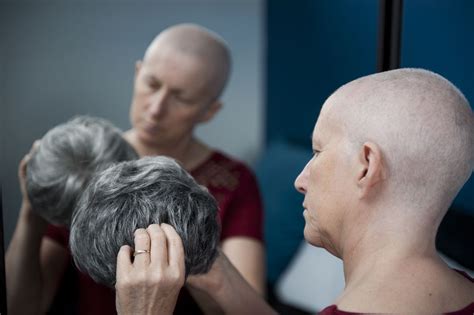Navigating the world of wigs as a cancer patient can be overwhelming, but with the right guidance, you can find the perfect fit that boosts your confidence and complements your unique style. Here are 5 crucial tips to help you make an informed decision:

1. Determine Your Cap Size and Head Shape
Before you start shopping, it’s essential to determine your cap size and head shape. Measure the circumference of your head at the widest point and consult a sizing chart to find your corresponding cap size. Additionally, consider your head shape (round, oval, square, or oblong) to ensure the wig fits comfortably and securely.
2. Choose the Right Fiber
Wigs come in three primary fiber types: synthetic, human hair, and a blend of both. Synthetic wigs are generally more affordable and require less maintenance. Human hair wigs offer a more natural look and feel but come with a higher price tag. Blended wigs provide a balance between cost and authenticity.
3. Consider Length and Coverage
The length and coverage of your wig will depend on your personal preferences and hair style. For a natural look, opt for a wig that matches your hair length before treatment. If you’re open to trying something new, you can experiment with different lengths and coverage options to complement your features.
4. Pick a Color That Flatters Your Skin Tone
When choosing a wig color, consider your skin tone and complexion. Warm skin tones look best with medium to dark brown, red, or gold wigs. Cool skin tones are complemented by cool brown, black, or blonde wigs. You can also consult a wig color chart or ask a professional for guidance.
5. Find a Trusted Wig Supplier
Finding a reputable wig supplier is crucial for ensuring quality and support. Look for suppliers who specialize in wigs for cancer patients, offer a wide selection, and provide personalized consultation. Make sure they have a refund or exchange policy in place if the wig doesn’t meet your expectations.
1. Custom Wigs
Custom wigs are designed specifically for each patient’s unique head shape and hair texture. They provide the most natural look and feel but are also the most expensive option.
2. Stock Wigs
Stock wigs are pre-made wigs available in various styles, colors, and sizes. They offer a convenient and affordable option, but they may not fit as perfectly as custom wigs.
3. Human Hair Wigs
Human hair wigs are made from real human hair, providing a natural look and feel. However, they require more maintenance and are prone to damage if not properly cared for.
4. Synthetic Wigs
Synthetic wigs are made from artificial fibers, making them more durable and affordable than human hair wigs. They are also easier to style and maintain.
1. Emotional Support
Wigs can provide emotional support and a sense of normality during a challenging time. They can help patients feel more confident and less self-conscious about their appearance.
2. Protection from the Sun and Cold
Wigs can protect the scalp from harmful UV rays and keep it warm during cold weather, especially if patients have lost their hair due to treatment.
3. Style and Confidence
Wigs allow cancer patients to experiment with different styles and colors, boosting their confidence and self-esteem. They can choose wigs that complement their features and enhance their overall appearance.
1. Active Lifestyle
Patients who lead an active lifestyle may want to choose a wig made from durable synthetic fibers that can withstand sweat and movement.
2. Easy Maintenance
Patients who prefer low-maintenance wigs may opt for synthetic wigs that require less styling and upkeep.
3. Versatility
Patients who want the flexibility to style their wig in different ways may prefer human hair wigs that can be cut, colored, and heat-styled.
1. Wash and Condition Regularly
Wash and condition synthetic wigs every 6-8 wears or more frequently if needed. Human hair wigs can be washed less frequently, every 10-12 wears or as needed. Use a mild shampoo and conditioner designed specifically for wigs.
2. Avoid Heat Styling
Synthetic wigs cannot be heat-styled, as heat can damage the fibers. Human hair wigs can be heat-styled, but use low heat settings to prevent damage.
3. Store Properly
When not in use, store your wig on a stand or in a box to prevent tangles. Avoid storing wigs in direct sunlight or in areas with high humidity.
4. Detangle Gently
Use a wide-toothed comb or wig brush to detangle your wig. Start brushing from the ends and work your way up to the roots.
1. Choosing the Wrong Cap Size
Wearing a wig that is too small or too large can be uncomfortable and insecure. Make sure to measure your head and choose a cap size that fits snugly.
2. Not Maintaining Your Wig
Regularly washing, conditioning, and styling your wig is essential to keep it looking its best and extend its lifespan.
3. Overusing Heat Styling
Heat styling can damage synthetic and human hair wigs. Avoid heat styling as much as possible, and always use low heat settings.
4. Storing Your Wig Improperly
Storing your wig properly is essential to prevent tangles and damage. Store your wig on a stand or in a box, and avoid storing it in direct sunlight or in areas with high humidity.
Choosing the right wig can be a transformative experience for cancer patients. By considering your individual needs and preferences, you can find a wig that boosts your confidence, protects your scalp, and complements your unique style. With proper care and maintenance, your wig can become a cherished companion throughout your treatment journey and beyond.
